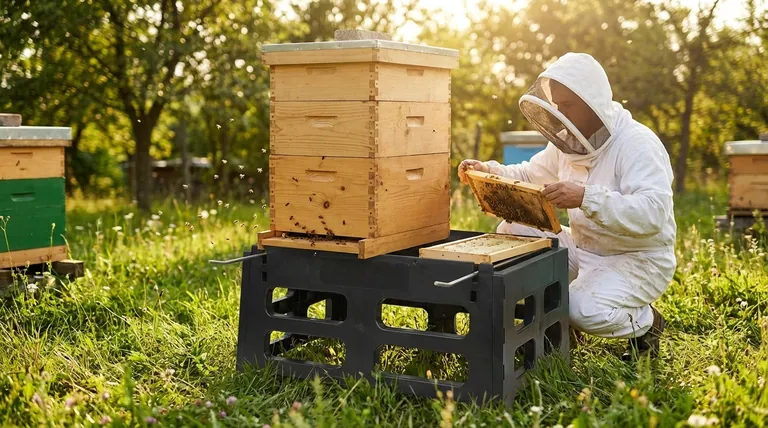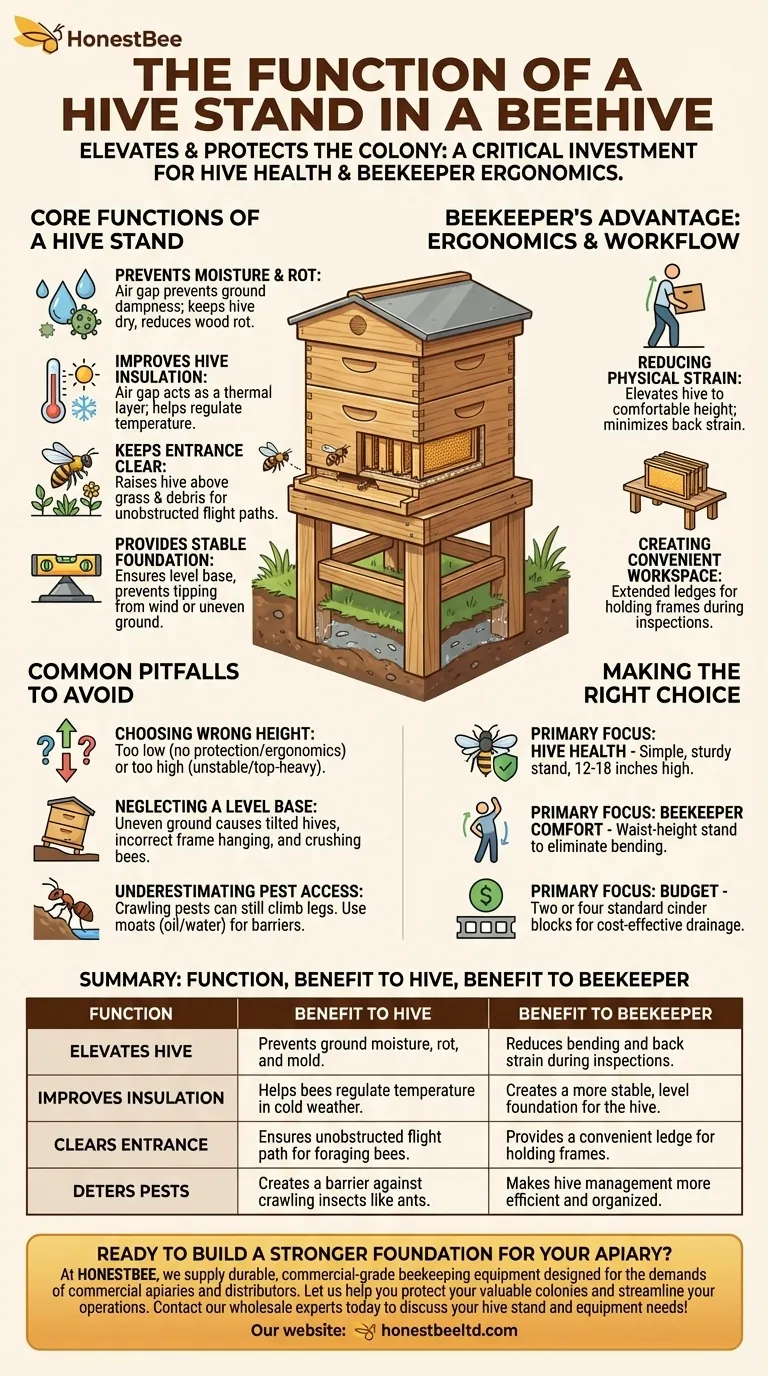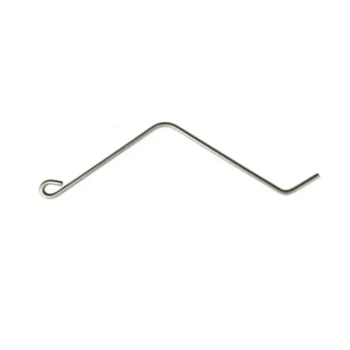At its core, a hive stand elevates the beehive off the ground. This simple act is fundamental to protecting the colony from the elements and making the beekeeper's job significantly easier and more effective. It serves as the foundation for a healthy, stable, and productive hive.
A hive stand is not merely a piece of equipment; it's a critical investment in hive health and beekeeper ergonomics. Its primary role is to create a buffer between the hive and the ground, solving problems ranging from moisture and rot to pest control and physical strain.

The Core Functions of a Hive Stand
A hive stand provides several essential benefits that directly impact the well-being of the honey bee colony. Each function addresses a common environmental threat.
Preventing Moisture and Rot
Elevating the hive creates an air gap underneath the bottom board. This circulation prevents moisture from the damp ground from wicking into the wood, which helps keep the hive dry and significantly reduces the risk of wood rot. A dry hive is crucial for preventing mold and maintaining a healthy internal environment for the bees.
Improving Hive Insulation
The ground is a major source of temperature fluctuation, becoming cold and damp in the winter. The air gap created by a stand acts as a layer of insulation, helping the colony better regulate its internal temperature and conserve energy, especially during colder months.
Keeping the Entrance Clear
A hive placed directly on the ground is quickly obstructed by growing grass, weeds, and debris. A stand raises the entrance above this vegetation, ensuring the bees have a clear flight path for foraging and ventilation.
Providing a Stable Foundation
A well-designed hive stand offers a solid, level base for the hive. This stability is critical, preventing the hive from tipping over due to uneven ground, wind, or accidental bumps during inspections.
The Beekeeper's Advantage: Ergonomics and Workflow
Beyond benefiting the bees, a hive stand is one of the most important tools for the beekeeper's own comfort and efficiency.
Reducing Physical Strain
Beekeeping involves lifting heavy boxes (supers) that can weigh over 50 pounds. A hive stand raises the entire setup to a more comfortable working height, drastically reducing the amount of bending and lifting that can lead to significant back strain.
Creating a Convenient Workspace
Many commercial and DIY hive stands are designed with extended sides or ledges. This provides a convenient and essential space to place frames during an inspection, keeping them clean, organized, and off the ground.
Common Pitfalls to Avoid
While a hive stand is highly beneficial, a few considerations are necessary to maximize its effectiveness and avoid creating new problems.
Choosing the Wrong Height
A stand that is too low will not provide adequate protection from splashing rain or pests and will offer little ergonomic benefit. Conversely, a stand that is too high can make the hive top-heavy and unstable in high winds. The ideal height balances accessibility with stability.
Neglecting a Level Base
Placing a stand on uneven ground will result in a tilted hive. This can cause frames to hang incorrectly and makes hive components difficult to separate, potentially crushing bees during inspections. Always ensure the ground beneath the stand is firm and level.
Underestimating Pest Access
While a stand deters many crawling pests, it's not a complete barrier. Ants, for example, can still climb the legs. Some beekeepers place the legs of their stands in containers of oil or water to create an effective moat, blocking this access route.
Making the Right Choice for Your Goal
Selecting or building a hive stand depends on your priorities as a beekeeper.
- If your primary focus is hive health: A simple, sturdy stand made of cinder blocks or pressure-treated wood that provides 12-18 inches of elevation is perfectly effective.
- If your primary focus is beekeeper comfort: Invest in or build a stand that raises the hive's bottom board to waist height to eliminate bending.
- If your primary focus is budget: Two or four standard cinder blocks provide excellent drainage, stability, and longevity for a minimal cost.
Ultimately, using a proper hive stand is a foundational step for sustainable and enjoyable beekeeping.
Summary Table:
| Function | Benefit to Hive | Benefit to Beekeeper |
|---|---|---|
| Elevates Hive | Prevents ground moisture, rot, and mold. | Reduces bending and back strain during inspections. |
| Improves Insulation | Helps bees regulate temperature in cold weather. | Creates a more stable, level foundation for the hive. |
| Clears Entrance | Ensures unobstructed flight path for foraging bees. | Provides a convenient ledge for holding frames. |
| Deters Pests | Creates a barrier against crawling insects like ants. | Makes hive management more efficient and organized. |
Ready to build a stronger foundation for your apiary? A proper hive stand is a small investment that delivers significant returns in hive health and beekeeper efficiency. At HONESTBEE, we supply durable, commercial-grade beekeeping equipment designed for the demands of commercial apiaries and distributors.
Let us help you protect your valuable colonies and streamline your operations. Contact our wholesale experts today to discuss your hive stand and equipment needs!
Visual Guide

Related Products
- Plastic Bee Hive Stand for Beekeeping
- Professional Engraved Round Hive Number Tags for Beekeeping
- Professional Ant-Proof Beehive Stand with Integrated Moat for Beekeeping
- Wholesales Dadant Size Wooden Bee Hives for Beekeeping
- Professional Galvanized Hive Strap with Secure Locking Buckle for Beekeeping
People Also Ask
- Why is it important to level a hive stand properly? Prevent Catastrophic Failure & Ensure Hive Health
- What are the advantages of a second hive if the queen is killed? The Ultimate Insurance Policy for Your Apiary
- What are the advantages of polystyrene hives for beekeeping? Boost Colony Health & Honey Yields
- What are the main differences between Langstroth and Top Bar Hive designs? Choose the Right Hive for Your Beekeeping Goals
- How does the longevity of plastic bee hives compare to wooden hives? Discover the Durable Choice



















